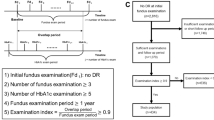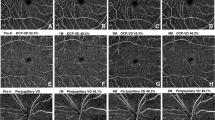Abstract
Purpose
The purpose of the study was to characterize the long-term effect of insulin pump therapy (CSII) on electroretinography and dark adaptometry and to examine the influence of baseline glycaemic control on retinal function in patients with type 1 diabetes mellitus.
Methods
This prospective observational extension study enrolled 13 patients out of 17 who completed a primary 1-year study of the effect of CSII on retinal function. Twelve patients were still on CSII at follow-up. The extension study included a single examination 3.5 years (range 3.0–4.0 years) after initiation of CSII of one study eye per patient. Procedures included full-field electroretinography (ERG), dark adaptometry, optical coherence tomography, and fundus photography.
Results
Mean ERG amplitudes 3.5 years after initiation of CSII were 15–43 % lower than at baseline (all p < 0.05) and 21–45 % lower than after 1 year on CSII. The mean rate of dark adaptation had returned to baseline after a transient 13 % (p = 0.0024) acceleration at the 1-year visit. Reduction of ERG amplitudes between 1 and 3.5 years was statistically associated predominantly with baseline haemoglobin A1c (HbA1c) ≥ 8.7 % and, to a smaller extent, with HbA1c reductions larger than 1.9 % after initiation of CSII. No significant changes in ERG amplitudes were found in patients with baseline HbA1c < 8.7 % and HbA1c reductions smaller than 1.9 %.
Conclusions
Deterioration of subclinical retinal function from 1 to 3.5 years after initiation of CSII was associated predominantly with poorer metabolic control before initiation of CSII. Analyses of retinal function may supplement structural and morphological characteristics in the study of diabetic complications.

Similar content being viewed by others
References
Davis MD, Fisher MR, Gangnon RE, Barton F, Aiello LM, Chew EY, Ferris FL III, Knatterud GL (1998) Risk factors for high-risk proliferative diabetic retinopathy and severe visual loss: Early Treatment Diabetic Retinopathy Study Report #18. Invest Ophthalmol Vis Sci 39:233–252
Porta M, Sjoelie AK, Chaturvedi N, Stevens L, Rottiers R, Veglio M, Fuller JH (2001) Risk factors for progression to proliferative diabetic retinopathy in the EURODIAB Prospective Complications Study. Diabetologia 44:2203–2209
Cheung N, Mitchell P, Wong TY (2010) Diabetic retinopathy. Lancet 376:124–136
Aiello LP (2014) Diabetic retinopathy and other ocular findings in the diabetes control and complications trial/epidemiology of diabetes interventions and complications study. Diabetes Care 37:17–23
Diabetes Control and Complications Trial Research Group (1998) Early worsening of diabetic retinopathy in the Diabetes Control and Complications Trial. Arch Ophthalmol 116:874–886
Kilpatrick ES, Rigby AS, Atkin SL (2008) A1C variability and the risk of microvascular complications in type 1 diabetes: data from the Diabetes Control and Complications Trial. Diabetes Care 31:2198–2202
Ostri C, Lund-Andersen H, Sander B, Hvidt-Nielsen D, Larsen M (2010) Bilateral diabetic papillopathy and metabolic control. Ophthalmology 117:2214–2217
Sander B, Larsen M, Andersen EW, Lund-Andersen H (2013) Impact of changes in metabolic control on progression to photocoagulation for clinically significant macular oedema: a 20 year study of type 1 diabetes. Diabetologia 56:2359–2366
Juen S, Kieselbach GF (1990) Electrophysiological changes in juvenile diabetics without retinopathy. Arch Ophthalmol 108:372–375
Jackson GR, Scott IU, Quillen DA, Walter LE, Gardner TW (2012) Inner retinal visual dysfunction is a sensitive marker of non-proliferative diabetic retinopathy. Br J Ophthalmol 96:699–703
Klemp K, Sander B, Brockhoff PB, Vaag A, Lund-Andersen H, Larsen M (2005) The multifocal ERG in diabetic patients without retinopathy during euglycemic clamping. Invest Ophthalmol Vis Sci 46:2620–2626
Amemiya T (1977) Dark adaptation in diabetics. Ophthalmologica 174:322–326
Di Leo MA, Caputo S, Falsini B, Porciatti V, Minnella A, Greco AV, Ghirlanda G (1992) Nonselective loss of contrast sensitivity in visual system testing in early type I diabetes. Diabetes Care 15:620–625
Holfort SK, Norgaard K, Jackson GR, Hommel E, Madsbad S, Munch IC, Klemp K, Sander B, Larsen M (2011) Retinal function in relation to improved glycaemic control in type 1 diabetes. Diabetologia 54:1853–1861
Jackson GR, Edwards JG (2008) A short-duration dark adaptation protocol for assessment of age-related maculopathy. J Ocul Biol Dis Infor 1:7–11
Marmor MF, Fulton AB, Holder GE, Miyake Y, Brigell M, Bach M (2009) ISCEV standard for full-field clinical electroretinography (2008 update). Doc Ophthalmol 118:69–77
Brinchmann-Hansen O, Dahl-Jorgensen K, Hanssen KF, Sandvik L (1992) Macular recovery time, diabetic retinopathy, and clinical variables after 7 years of improved glycemic control. Acta Ophthalmol (Copenh) 70:235–242
Brinchmann-Hansen O, Dahl-Jorgensen K, Hanssen KF, Sandvik L (1988) Oscillatory potentials, macular recovery time, and diabetic retinopathy through 3 years of intensified insulin treatment. Ophthalmology 95:1358–1366
Frost-Larsen K, Larsen HW, Simonsen SE (1981) Value of electroretinography and dark adaptation as prognostic tools in diabetic retinopathy. Dev Ophthalmol 2:222–234
Vadala M, Anastasi M, Lodato G, Cillino S (2002) Electroretinographic oscillatory potentials in insulin-dependent diabetes patients: a long-term follow-up. Acta Ophthalmol Scand 80:305–309
Hellgren KJ, Agardh E, Bengtsson B (2014) Progression of early retinal dysfunction in diabetes over time: results of a long-term Prospective Clinical Study. Diabetes 63:3104–3111
Brunette JR, Lafond G (1983) Electroretinographic evaluation of diabetic retinopathy: sensitivity of amplitude and time of response. Can J Ophthalmol 18:285–289
Wachtmeister L (1998) Oscillatory potentials in the retina: what do they reveal. Prog Retin Eye Res 17:485–521
Gjotterberg M (1974) The electroretinogram in diabetic retinopathy. A clinical study and a critical survey. Acta Ophthalmol (Copenh) 52:521–533
Tyrberg M, Lindblad U, Melander A, Lovestam-Adrian M, Ponjavic V, Andreasson S (2011) Electrophysiological studies in newly onset type 2 diabetes without visible vascular retinopathy. Doc Ophthalmol 123:193–198
Holfort SK, Klemp K, Kofoed PK, Sander B, Larsen M (2010) Scotopic electrophysiology of the retina during transient hyperglycemia in type 2 diabetes. Invest Ophthalmol Vis Sci 51:2790–2794
Birch DG, Anderson JL (1992) Standardized full-field electroretinography. Normal values and their variation with age. Arch Ophthalmol 110:1571–1576
Freund PR, Watson J, Gilmour GS, Gaillard F, Sauve Y (2011) Differential changes in retina function with normal aging in humans. Doc Ophthalmol 122:177–190
Acknowledgments
The present study was supported by the University of Copenhagen and Øjenforeningen (Fight For Sight, Denmark). The electroretinographic results of the present paper were presented at ARVO 2013, Association for Research in Vision and Ophthalmology. Seattle, WA, 6 May 2013.
Conflict of interest
No conflicts of interest. None of the authors have a proprietary interest.
Author information
Authors and Affiliations
Corresponding author
Rights and permissions
About this article
Cite this article
Klefter, O.N., Holfort, S.K. & Larsen, M. Baseline haemoglobin A1c influences retinal function after long-term insulin pump therapy. Graefes Arch Clin Exp Ophthalmol 254, 467–473 (2016). https://doi.org/10.1007/s00417-015-3083-2
Received:
Revised:
Accepted:
Published:
Issue Date:
DOI: https://doi.org/10.1007/s00417-015-3083-2




